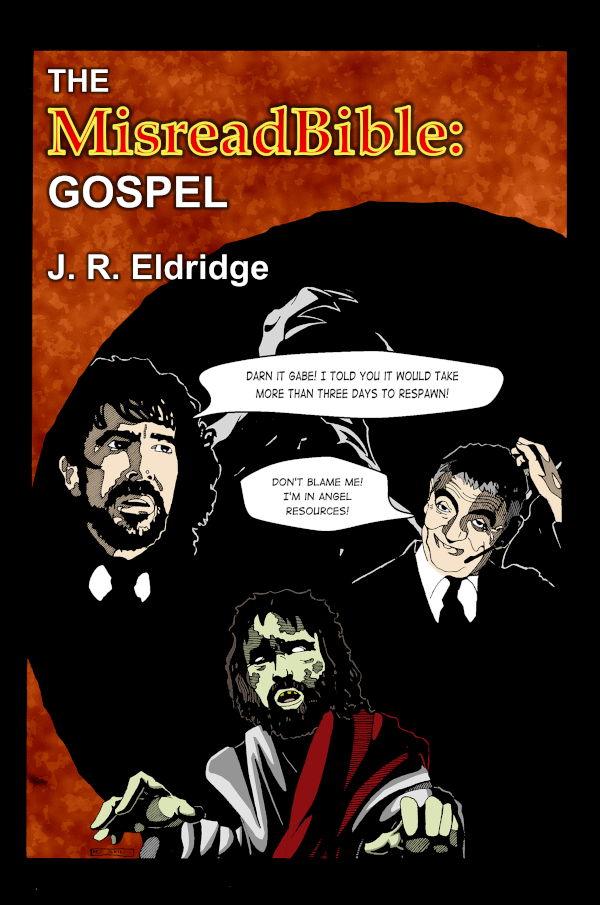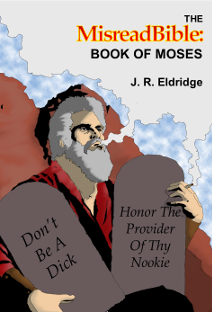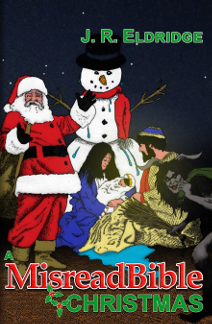Misreading the Bible
A lot of writers talk about their ‘process’, the manner in which they go about writing their books. Based on what I’ve heard from other authors I’ve spoken to, there is no one universal process that all authors use. So for this post, I thought it might be interesting to write about my process and the unique steps involved in parodying a book like the Bible.
The first step is to actually read the Bible. I’ve read everything before, but it’s a good idea for me to have the stories fresh in my mind. It also allows me to see if any jokes or potential plot twists jump out at me; as I’ve said before, a lot of the verses and stories are bizarre even without my patented brand of ‘misreading’.
As I’ve mentioned in previous posts, there are many issues with the Bible. The gospels present a unique challenge as there are multiple versions of each story. Christian theologians have attempted to reconcile this by creating tables of corresponding verses called harmonies (I discuss them here). I’ve been using a similar tactic to put the narratives in order (something I started doing while I was writing my second book, A MisreadBible Christmas). I use Excel to create tables and work out which verses constitute a narrative and organise them into stories and sections.
Here’s part of the table for my next book.

(Click to view larger image)
I’ve tried, where possible, to keep narratives that follow on from each other together (I’ve drawn thick borders around contiguous narratives), but as the order is different in each gospel, it’s impossible for all of the narratives in all four gospels to be in order, so I’ve chosen to base mine predominantly around Luke and John.
In some instances, I’ve shuffled things around a bit to improve the overall plot. For instance, The Lord’s Many Stalkers (based on Matthew 9:27-34) comes before A Paralytic Drops in (Matthew 9:1-8) and Slipping into Levi’s (Matthew 9:9-17) because it creates a more dramatic build up as more and more people flock to Jesus wanting to be healed.
Once I’ve got the stories into a rough order, I begin looking at individual narratives more closely. When I come across passages where the meaning is uncertain or that contradict others, I read commentaries to see how Christian theologians interpret them, and I also look at what secular scholars have written on the subject. I take copious notes that I can refer to later when I write the stories.
When real historical figures are mentioned, I research them to find out how accurate the details about them in the Bible are. When I was writing my second book, I parodied A Christmas Carol by Charles Dickens, casting Herod the Great as Scrooge. I based the events of his life in my story on real events in Herod’s life whilst also linking to the Bible nativity narrative.
My main concerns when writing my adaptations are consistency, dealing with contradictions, giving the characters personality, and finding ways to deal with the boring sections of the Bible (usually things like the chapters of begats).
The characters in the Bible are generally lifeless and dry, going through the motions in order to progress the story. It’s often difficult to work out their motivations or connect to them on an emotional level. I try to imbue them with life and give them longer character arcs. In my current book, I have quite a few characters to work with: Jesus himself, John the Baptist, Jesus’s disciples, Mary Magdalene, and a host of others. Sometimes, the personality of a character develops naturally, but other times, I have to think of what traits would work well in the situations presented by the stories and with other characters. Again, I take copious notes.
Throughout the whole process, I allow myself to shift the order of narratives and try to create an outline of overall story arcs. Obviously, the Bible has its own story arc (although, it’s usually underdeveloped and inconsistent), but I like to add in my own subplots and twists throughout the larger story.
Now I can begin writing. In sections of the Bible where there is a single version of the narrative, I’ll copy the text from BibleGateway into a Word document and go verse by verse writing my version of the story above the original, deleting verses from the original as I go. I try to retain the positions of the verse numbers.
In other sections, however (such as the gospels), there are multiple versions of each story. I have to compare the various versions and work out which details from each I want to keep. This can be a difficult task, but I’ve created a database and webpage hosted on my computer that allows me to view corresponding narratives from different gospel books side-by-side. Once I’ve figured out which parts I want to use from each gospel, I copy the text into Word and go through the verse-by-verse process as before, adding in any details from the other gospels if necessary.
Then, of course, the final step is proofreading and editing. Proofreading isn’t just about catching spelling and grammar mistakes, it’s also an opportunity to assess the story as a whole. Sometimes when I’m proofreading, I’ll find that something needs to be completely rewritten or that the plot isn’t working in some places and needs to be adjusted.
One thing I’ve noticed about myself is that when I read back what I’ve written, I tend to read things as they should be written rather than how they are actually written. Having other people proofread helps a lot in this regard, as does reading my stories out loud to other people. Another thing I’ve started to use is Word’s ‘Read aloud’ feature, which reads what I wrote verbatim.
No matter how much prep work you put into writing, proofreading and being willing to revise and polish your work is vital. It’s very rare that you’ll write something flawless in your first draft. I used to get really bogged down in scrutinising my writing as I wrote. I’d be in mid-flow and grind to a halt trying to get the phrasing exactly right. Eventually, I trained myself to ignore all of those things as I am writing and try to just keep writing. If there are any errors (I can guarantee there will be), I can always correct them later.





